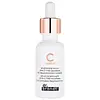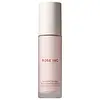What's inside
What's inside
 Key Ingredients
Key Ingredients

 Benefits
Benefits

 Concerns
Concerns

 Ingredients Side-by-side
Ingredients Side-by-side

Water
Skin ConditioningTetrahexyldecyl Ascorbate
AntioxidantC9-12 Alkane
SolventPPG-24-Glycereth-24
EmulsifyingPropanediol
SolventGlycerin
HumectantPotassium Cetyl Phosphate
EmulsifyingCaprylic/Capric Triglyceride
MaskingGlyceryl Stearate
EmollientPEG-100 Stearate
1,2-Hexanediol
Skin ConditioningHexylresorcinol
AntimicrobialEthyl Linoleate
EmollientPlankton Extract
Skin ConditioningBioflavonoids
Skin ConditioningGlucose
HumectantLecithin
EmollientLavandula Angustifolia Oil
MaskingLavandula Hybrida Oil
EmollientCitric Acid
BufferingCitrus Aurantium Dulcis Peel Extract
Emulsion StabilisingTocopheryl Acetate
AntioxidantXanthan Gum
EmulsifyingCoco-Caprylate/Caprate
EmollientAcrylates/C10-30 Alkyl Acrylate Crosspolymer
Emulsion StabilisingPhenethyl Alcohol
MaskingPolyglyceryl-6 Polyricinoleate
EmulsifyingPentylene Glycol
Skin ConditioningTocopherol
AntioxidantAminomethyl Propanol
BufferingDisodium EDTA
Linalyl Acetate
MaskingChlorogenic Acids
AntioxidantSodium Ascorbate
AntioxidantPhenoxyethanol
PreservativeLinalool
PerfumingLimonene
PerfumingGeraniol
PerfumingWater, Tetrahexyldecyl Ascorbate, C9-12 Alkane, PPG-24-Glycereth-24, Propanediol, Glycerin, Potassium Cetyl Phosphate, Caprylic/Capric Triglyceride, Glyceryl Stearate, PEG-100 Stearate, 1,2-Hexanediol, Hexylresorcinol, Ethyl Linoleate, Plankton Extract, Bioflavonoids, Glucose, Lecithin, Lavandula Angustifolia Oil, Lavandula Hybrida Oil, Citric Acid, Citrus Aurantium Dulcis Peel Extract, Tocopheryl Acetate, Xanthan Gum, Coco-Caprylate/Caprate, Acrylates/C10-30 Alkyl Acrylate Crosspolymer, Phenethyl Alcohol, Polyglyceryl-6 Polyricinoleate, Pentylene Glycol, Tocopherol, Aminomethyl Propanol, Disodium EDTA, Linalyl Acetate, Chlorogenic Acids, Sodium Ascorbate, Phenoxyethanol, Linalool, Limonene, Geraniol
Water
Skin ConditioningCoco-Caprylate/Caprate
EmollientCaprylic/Capric Triglyceride
MaskingPropanediol
SolventSqualane
EmollientGlycerin
HumectantLimnanthes Alba Seed Oil
Skin ConditioningPentylene Glycol
Skin ConditioningCastor Oil/Ipdi Copolymer
Ascorbyl Tetraisopalmitate
AntioxidantTocopherol
AntioxidantCrithmum Maritimum Extract
Skin ConditioningTamarindus Indica Seed Gum
Emulsion StabilisingSilica
AbrasiveHelianthus Annuus Seed Oil
EmollientGlucose
HumectantCellulose Gum
Emulsion StabilisingMicrocrystalline Cellulose
AbsorbentAcrylates/C10-30 Alkyl Acrylate Crosspolymer
Emulsion StabilisingTrisodium Ethylenediamine Disuccinate
Mica
Cosmetic ColorantCI 77491
Cosmetic ColorantCI 77891
Cosmetic ColorantBenzyl Alcohol
PerfumingSodium Hydroxide
BufferingCitrus Aurantium Amara Flower Oil
MaskingCitrus Aurantium Bergamia Fruit Oil
MaskingPogostemon Cablin Leaf Oil
MaskingFarnesol
PerfumingGeraniol
PerfumingLimonene
PerfumingLinalool
PerfumingWater, Coco-Caprylate/Caprate, Caprylic/Capric Triglyceride, Propanediol, Squalane, Glycerin, Limnanthes Alba Seed Oil, Pentylene Glycol, Castor Oil/Ipdi Copolymer, Ascorbyl Tetraisopalmitate, Tocopherol, Crithmum Maritimum Extract, Tamarindus Indica Seed Gum, Silica, Helianthus Annuus Seed Oil, Glucose, Cellulose Gum, Microcrystalline Cellulose, Acrylates/C10-30 Alkyl Acrylate Crosspolymer, Trisodium Ethylenediamine Disuccinate, Mica, CI 77491, CI 77891, Benzyl Alcohol, Sodium Hydroxide, Citrus Aurantium Amara Flower Oil, Citrus Aurantium Bergamia Fruit Oil, Pogostemon Cablin Leaf Oil, Farnesol, Geraniol, Limonene, Linalool
 Reviews
Reviews

Ingredients Explained
These ingredients are found in both products.
Ingredients higher up in an ingredient list are typically present in a larger amount.
Acrylates/C10-30 Alkyl Acrylate Crosspolymer is a synthetic polymer. It is used to thicken and improve the texture of products. Due to its properties, it can prevent water and oil ingredients from separating.
This ingredient is an emollient, solvent, and texture enhancer. It is considered a skin-softener by helping the skin prevent moisture loss.
It helps thicken a product's formula and makes it easier to spread by dissolving clumping compounds.
Caprylic Triglyceride is made by combining glycerin with coconut oil, forming a clear liquid.
While there is an assumption Caprylic Triglyceride can clog pores due to it being derived from coconut oil, there is no research supporting this.
Learn more about Caprylic/Capric TriglycerideCoco-Caprylate/Caprate is created from fatty coconut alcohol, caprylic acid, and capric acid.
It is a lightweight emollient. Emollients create a thin barrier on the skin to trap moisture in. This helps keep your skin hydrated and soft.
Once applied, Coco-Caprylate/Caprate is absorbed quickly and leaves a silky feel.
Coco-Caprylate/Caprate may not be fungal acne safe.
Learn more about Coco-Caprylate/CaprateGeraniol is used to add fragrance/parfum to a product. It is the main component of citronellol. It is a monoterpenoid and an alcohol.
Monoterpenes are naturally found in many parts of different plants.
Geraniol can be found in many essential oils including Rose Oil and Citronella Oil. The scent of Geraniol is often described as "rose-like". Many foods also contain Geraniol for fruit flavoring.
Geraniol can irritate the skin when exposed to air. However, irritation depends on the ability of geraniol to penetrate into the skin. In general, geraniol is not able to penetrate skin easily.
Geraniol is colorless and has low water-solubility. However, it is soluble in common organic solvents.
Like citronellol, it is a natural insect repellent.
2,6-Octadien-1-ol, 3,7-dimethyl-, (2E)-
Learn more about GeraniolGlucose is a simple sugar and is the most important source of energy in all organisms.
In skincare, glucose is used to hydrate the skin. It also acts as a prebiotic for our natural biome.
Glucose is hydrating due to its humectant property. As a humectant, glucose draws moisture from the air and from deeper levels in the skin.
Our skin contains many sugars that act as prebiotics and help strengthen our natural microbiome. Having a healthy microbiome helps protect our skin from harmful bacteria and other contaminants.
Studies show glucose may help with fading discoloration and pigmentation. This is because our skin metabolizes glucose into lactic acid. Lactic acid is an AHA that helps exfoliate the top layer of skin.
Learn more about GlucoseGlycerin is already naturally found in your skin. It helps moisturize and protect your skin.
A study from 2016 found glycerin to be more effective as a humectant than AHAs and hyaluronic acid.
As a humectant, it helps the skin stay hydrated by pulling moisture to your skin. The low molecular weight of glycerin allows it to pull moisture into the deeper layers of your skin.
Hydrated skin improves your skin barrier; Your skin barrier helps protect against irritants and bacteria.
Glycerin has also been found to have antimicrobial and antiviral properties. Due to these properties, glycerin is often used in wound and burn treatments.
In cosmetics, glycerin is usually derived from plants such as soybean or palm. However, it can also be sourced from animals, such as tallow or animal fat.
This ingredient is organic, colorless, odorless, and non-toxic.
Glycerin is the name for this ingredient in American English. British English uses Glycerol/Glycerine.
Learn more about GlycerinLimonene is a fragrance that adds scent and taste to a formulation.
It's found in the peel oil of citrus fruits and other plants such as lavender and eucalyptus. The scent of limonene is generally described as "sweet citrus".
Limonene acts as an antioxidant, meaning it helps neutralize free radicals.
When exposed to air, oxidized limonene may sensitize the skin. Because of this, limonene is often avoided by people with sensitive skin.
The term 'fragrance' is not regulated in many countries. In many cases, it is up to the brand to define this term. For instance, many brands choose to label themselves as "fragrance-free" because they are not using synthetic fragrances. However, their products may still contain ingredients such as essential oils that are considered a fragrance.
Learn more about LimoneneLinalool is a fragrance and helps add scent to products. It's derived from common plants such as cinnamon, mint, citrus, and lavender.
Like Limonene, this ingredient oxidizes when exposed to air. Oxidized linalool can cause allergies and skin sensitivity.
This ingredient has a scent that is floral, spicy tropical, and citrus-like.
Learn more about LinaloolPentylene glycol is typically used within a product to thicken it. It also adds a smooth, soft, and moisturizing feel to the product. It is naturally found in plants such as sugar beets.
The hydrophilic trait of Pentylene Glycol makes it a humectant. As a humectant, Pentylene Glycol helps draw moisture from the air to your skin. This can help keep your skin hydrated.
This property also makes Pentylene Glycol a great texture enhancer. It can also help thicken or stabilize a product.
Pentylene Glycol also acts as a mild preservative and helps to keep a product microbe-free.
Some people may experience mild eye and skin irritation from Pentylene Glycol. We always recommend speaking with a professional about using this ingredient in your routine.
Pentylene Glycol has a low molecular weight and is part of the 1,2-glycol family.
Learn more about Pentylene GlycolPropanediol is an all-star ingredient. It softens, hydrates, and smooths the skin.
It’s often used to:
Propanediol is not likely to cause sensitivity and considered safe to use. It is derived from corn or petroleum with a clear color and no scent.
Learn more about PropanediolTocopherol (also known as Vitamin E) is a common antioxidant used to help protect the skin from free-radicals and strengthen the skin barrier. It's also fat soluble - this means our skin is great at absorbing it.
Vitamin E also helps keep your natural skin lipids healthy. Your lipid skin barrier naturally consists of lipids, ceramides, and fatty acids. Vitamin E offers extra protection for your skin’s lipid barrier, keeping your skin healthy and nourished.
Another benefit is a bit of UV protection. Vitamin E helps reduce the damage caused by UVB rays. (It should not replace your sunscreen). Combining it with Vitamin C can decrease sunburned cells and hyperpigmentation after UV exposure.
You might have noticed Vitamin E + C often paired together. This is because it is great at stabilizing Vitamin C. Using the two together helps increase the effectiveness of both ingredients.
There are often claims that Vitamin E can reduce/prevent scarring, but these claims haven't been confirmed by scientific research.
Learn more about TocopherolWater. It's the most common cosmetic ingredient of all. You'll usually see it at the top of ingredient lists, meaning that it makes up the largest part of the product.
So why is it so popular? Water most often acts as a solvent - this means that it helps dissolve other ingredients into the formulation.
You'll also recognize water as that liquid we all need to stay alive. If you see this, drink a glass of water. Stay hydrated!
Learn more about Water